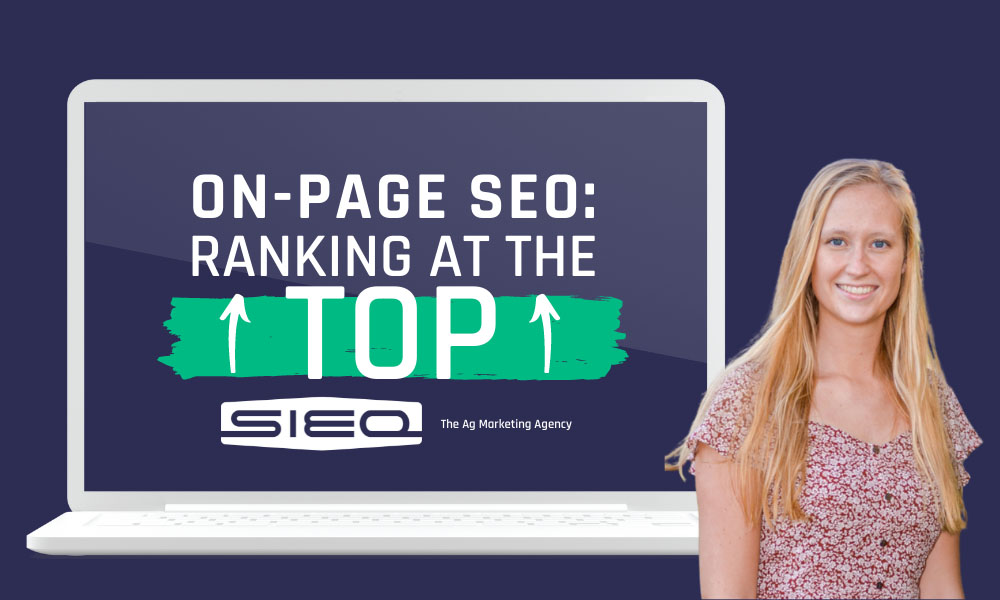On-Page SEO Guide: Ranking At The Top

When you query something on Google, or any other search engine, which pages are you most likely to click on? The ones that are hidden at the bottom of the third page, or the ones conveniently placed at the top of the first page? If I had to take a wild guess as to what your answer is, I would say the ones found at the top of the first page. They tend to be the pages that are most relevant to the topic you are searching and they are easy to access. In a world where time is seemingly in short supply, we like things to be served to us quickly. We don’t want to spend precious minutes sifting through pages of search results to find what we are looking for. So how can you make sure the pages you are creating are showing up at the top and to the appropriate audience? We’ve got your answer, On-Page SEO. Thanks to Google’s spidey senses and well-developed algorithms, it is more important than ever to create high-quality content that answers the questions searchers have in the most efficient way possible.
Know Your Audience & What They Are Searching
To get your pages in front of the correct audience, you need to know what they are searching for and how they are searching. There are several platforms you can use to conduct keyword research. Some popular ones are Moz, SEMRush, AnswerThePublic, and KeywordTool.io.
Through these sites, you can put in brand-relevant words and phrases to get insight into things like how people are searching for related topics, how much search volume specific keywords have, and more. Google Search Console is also a great tool to use. This console shows you the keywords your website shows up for in searches. These insights help you know what keywords your audience is actively using to gather information as well as how your website is performing in searches with those keywords.
Creating keyword-focused pages is a good way to beef up your online presence, but be careful how you go about it. When writing pages that are focused around specific keywords, it’s easy to go overboard trying to include them in the page as much as possible, but Google isn’t a fan. Keyword stuffing is one of the quickest ways to get Google not to show your page. So how many times is enough and how many times is too much? Sadly, there isn't a magic number for how many times a keyword should be included but think of it this way- if it would naturally flow in a conversation, include it, but if it sounds repetitive or like you are trying to force it, leave it out. One formula that can be used as a general guide is the keyword density formula. This formula figures the number of times your target keyword is mentioned as a percentage in relation to the total number of words. A good rule of thumb is to have a keyword density of 0.5-2%.
Tip: Instead of doing separate pages for different keywords that refer to the same product/service, include the various keywords in the same page. It increases the page's value and allows you to focus more time on one page and keeps your site from having a bunch of duplicate content, another thing Google doesn’t like.
Cut The Fluff… But Not The Good Stuff
There is a constant back-and-forth debate about whether short-form or long-form writing performs better, and ultimately, it boils down to if the page effectively covers the subject at hand. If you can answer the viewers’ questions in a short and concise way without them needing to go to another page to get their answer, great, but if you need to take time explaining the subject matter, do it.
For example, if you know your audience is curious about a specific product feature and you decide to write a page explaining how it works, you can likely cover the topic in a few hundred words. However, if you are creating a page on an entire lineup of products you offer, you might need to use more words to convey the information to the audience.
To sum it up, cut the fluff and stick to the good stuff.
Tip: If you feel like some searchers might just need a brief overview and others might need more information, laying your page out in sections with key headers is a good way to meet the needs of both.
Pay Attention To Little Details, They Matter
· Page Title
It may seem a little silly to even mention it but make sure to include the keyword your page is about in the title (but don’t stuff). This is the first thing search engines and viewers look at when they come across your page. The title is how they know what the page is about.
· Headers
Not only do headers make the page easier to read, they also help show Google which content is most important. H1 is the main header tag and should be used for the page title. Subsequent headers, such as H2, H3, etc, represent descending levels of importance. As the header number increases, the topic being discussed should be getting more and more specific. For example, the title of this page is an H1 heading, the main three subsections are H2 headings, and these bullet points are H3 headings.
· Meta Description
Meta descriptions are what show up under the page title on the search engine results page (SERP). This field is a little bit different than the other sections of optimizations we cover because sometimes Google selects text from the page that it feels is most relevant to the search even if you provided a specific description to be used. However, this doesn’t mean it’s not important to have one. Ideally, the description is a compelling sentence that summarizes what the page is about. The meta descriptions can play a large role in if someone clicks on your page or not. If no one is clicking on your page, Google may see it as being irrelevant and stop showing it to searchers.
· Photo Size
Photo sizes play one of the largest roles in page load time, which Google pays close attention to. The longer it takes a page to load, the more likely readers are to back off the page and click on a different one. Make sure the images you are using are compressed for posting on your website.
· Photo Alt Text
The main purpose of alt text is for people using screen readers to know what the picture is about, however, Google also looks at this field. Including alt text isn’t only helpful for those with visual impairments, it also helps Google understand the purpose of the photos and verify they correspond with the content. Be descriptive and specific with alt text. Including accurate information in this field is an easy way to improve pages.
· Internal Linking
If you mention a topic in your page that you have previously written content about or have another page on your website that correlates with it, link it in the text of the page. When readers click on these links, it keeps them on your website longer, which shows Google your pages are valuable to viewers.
Feel a little bit like you’ve just been trying to drink out of a fire hose? We understand. It is a lot to process and put into practice. For any questions about how you can bring your pages up to snuff through On-Page SEO, reach out to our Content & SEO team.



